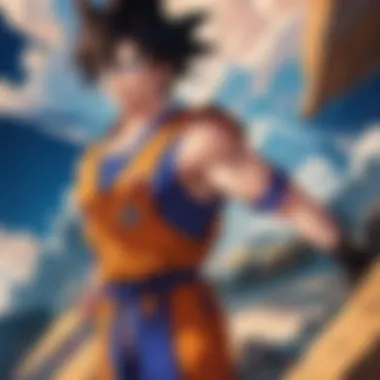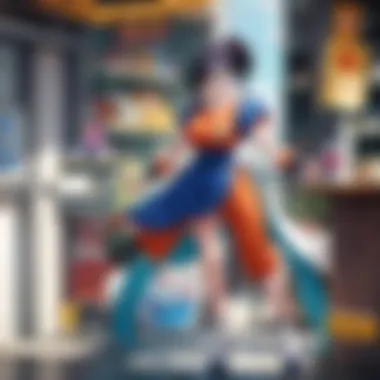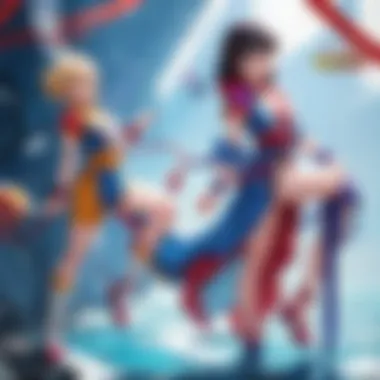Exploring Dragon Ball Z: A Comprehensive Guide to the Iconic Anime


Intro
Dragon Ball Z has solidified itself as a landmark of anime, exerting a profound influenced over both the genre and its audience since its inception. With intricate narratives, complex characters, and exhilarating battles, this series has carved a unique place in pop culture. By delving deep into the realms of Dragon Ball Z, this article aims to shed light on its thematic depth, character evolution, and the broader implications within the anime world.
The narrative of Dragon Ball Z transcends simple entertainment; it subtly addresses concepts of friendship, sacrifice, and perseverance. Origins tracing back to the historic Dragon Ball series, it layered rich narratives atop its action-oriented facade. Importantly, the series does not merely engage in fight sequences but employs these confrontations as means through which character growth unfolds.
A reader may wonder how they could best navigate through such a vast universe. This article will act as a crucial roadmap, assisting viewers in orientation, analysis, and appreciation. Also, we will explore the prevalent adaptations and intricate details regarding merchandise, allowing audiences to gain a comprehensive understanding of Dragon Ball Z's cultural and historical significance.
Prelude to Dragon Ball Z
An Overview of the Series
Dragon Ball Z stands as a monumental chapter in the realm of anime, building upon the foundations laid by its predecessor, Dragon Ball. It debuted on television in Japan in 1989 and quickly became a global sensation. The series follows the adventures of Goku, his family, and friends as they confront daunting threats to the universe. Its formula combines action with deepening character arcs and vibrant animation, enthralling audiences across generations.
The show's essential appeal lies in its exciting battles, but what makes it profound is the transformation of characters. Goku evolves not only as a fighter but as a person. This series finesse deftly marries thrilling battles with genuine emotional growth. A notable hallmark is the way it deepens the backstories of both supporting heroes and infamous villains, creating a tapestry of interwoven narratives that pulls viewers in. During its runtime, it introduced innovative concepts, like Ultra Instinct and various transformations, marking it as a differentiating factor from other anime.
Key viewers are divided into two categories: long-time fans who grew up experiencing the print of the original manga, and new studs who draw in through streaming platforms. Each can appreciate the layers of storytelling, camaraderie, and determination offered by Dragon Ball Z.
The Legacy of Akira Toriyama
Akira Toriyama, the prolific mind behind Dragon Ball Z's creation, holds a pivotal role in modern anime culture. His artistic style and storytelling methods have left indelible marks, influencing a legion of forthcoming artists.
Beyond creating a fighting legend in Goku, Toriyama's worldbuilding laid the groundwork for future narratives in anime. Characters are more than one-dimensional traits; they resonate because of the complex emotions they portray. This has shaped how subsequent series construct their characters, often seeking to replicate his success.
Moreover, Toriyama's aura of creativity extended past Dragon Ball Z alone, painting motifs prevalent in manga today. His humor (however subtle) threaded through intense plots, allowing a nuanced conversational balance. Tracks like Dragon Quest showcase his talent further, pyramiding his legacy as an unmatched cultural figure.
“Art is not freedom from discipline, but disciplined freedom.” - Akira Toriyama
It is crucial to recognize how Dragon Ball Z solidified Toriyama’s impact, opening doors not only for himself but also for aspiring creators around the world. The series stands as a reflection of his innovative spirit, making it incomparably significant in the anime domain.
Understanding the Plot Structure
Understanding the plot structure of Dragon Ball Z offers layered insights into its narrative construction and character journeys. This series employs several story arcs with distinct yet interconnected narratives that form its overall storyline. Each saga enhances the depth and continuity of the universe, making it essential to grasp how these elements mix to influence viewer engagement and connection with characters.
The Story Arc Breakdown
Raditz Saga
The Raditz Saga kicks off the Dragon Ball Z experience. It is significant primarily because it introduces key characters such as Goku's brother, Raditz, bringing a new layer to Goku's identity. This saga is frequently perceived as a transition, moving from the more comedic nature of the original series to a tone marked by more serious conflicts.
A key characteristic is it serves to establish the themes of family and destiny, connecting Goku with that legacy of Saiyans. Its unique feature is that it portrays the essence of the battles that follow — struggles against powerful foes will become the series’ cornerstone. However, while the characterization and set up are strong, the pacing may seem slow for those familiar with intense anime from the outset, giving it a mixed reception among fans.
Frieza Saga
Following the Raditz is the Frieza Saga, noted for one of the longest and most dramatic battles in the series. This saga expands on the backstory of both Goku and the legendary super Saiyan transformation. Leave a profound mark on anime history with its intense showdown against Frieza, arguably one of the strongest villains.
Its atmosphere stimulates not just action but profound emotional weight, often leading to character development moments — notably, Goku’s evolution through adversity. The saga introduces iconic moments. One disadvantage is that it can feel overly prolonged during extended fight sequences which may lessen the feeling of tension toward the ending.
Cell Saga
The Cell Saga marks a pivotal point in character development, focusing largely on themes of sacrifice and choice. Cell is a multidimensional antagonist. His pursuit for 'perfection' forces characters, particularly Gohan, to grapple with their moral boundaries. This conflict makes it compelling as Gohan emerges in a leader’s capacity, arguably marking the torch-passing moment in the series.


The Cell Game concept is unique, allowing viewers to experience battles under a specific, regulated set of rules. Some fans express frustration about not allowing other characters the limelight; however, the artistry of emotions makes up for it, pushing it as a beneficial narrative arc.
Buu Saga
The last major saga is known as the Buu Saga. This section wraps up several character arcs and takes them on one last rollercoaster of battles ranging from serious to outlandishly comedic situations. It challenges ideals, with themes including reform and redemption explored through Buu’s character evolution.
It introduces new transformations, such as Fusion and the ability for characters to unite for powerful collective attacks. This saga is distinct for its variety, combining intense conflict with lighter moments that resonate with fans on different levels. However, some perceive it as diverging far from character motives and leading into comedic territory, thus may feel less focused than previous arcs.
Key Themes and Messages
The Dragon Ball Z series is rich in themes that resonate deeply with its viewers. These include values like perseverance, friendship, and the will to protect one’s loved ones. Each character embodies different aspects of these themes throughout the arcs, making it relatable on many levels.
“Struggles shape strength, and the battle for what’s just transcends beyond mere physical confrontations.”
Each plot point intertwines, enhancing the general messages of growth through conflict and the significance of those bonds formed induring one’s journey. Overall understanding the plot structure significantly elevates the appreciation of Dragon Ball Z, revealing just how deeply interconnected the narratives and character arcs are.
Character Analysis
Character analysis forms a crucial part of understanding Dragon Ball Z. This series is not just known for epic battles but also for its rich character development that boosts viewer engagement. The characters evolve in response to their surroundings and personal challenges which enhances narrative depth. Through examining the protagonists, antagonists, and their growth, we can appreciate the structure of the story more deeply.
Main Characters Overview
Goku
Goku, the face of the series, embodies optimism and extravagant potential. His innate drive to improve and protect those he loves establishes him not just as a fighter but as the emotional core of the story. This characteristic positions Goku as a relatable hero for many viewers. His unique ability to turn foes into friends leads to plot twists that are advantageous in the series as it keeps the dynamic alive. However, his simplicity in judgment often lands him in troublesome situations, reflecting the nuances of his character complexity.
Vegeta
Vegeta presents a counterbalance to Goku's personality. As a proud warrior prince, he offers a darker, more intense aspect to the narrative. His transformation from antagonist to anti-hero becomes a significant plot evolution. Fans appreciate his struggle against his past and constant strive for power, making his character development engaging. However, his deep-rooted pride sometimes limits his growth, which may be seen as a disadvantage, but it underscores his inherent tension with Goku nicely.
Piccolo
Piccolo stands out as a character who bridges antagonism and alliance. Once a fierce enemy, he transitions into a mentor, adding complexity to his personality. His strategic mindset allows him to be an essential ally during high-stakes moments. Fans resonate with Piccolo's character as it highlights themes of redemption. However, his serious demeanor can contrast starkly with the more light-hearted characters in the series, which may not appeal to everyone.
Gohan
Gohan's character examines the tension between obligation and choice. As Goku’s son, he entertains deep expectations to follow in his father’s footsteps yet frequently exhibits a desire for peace. His arc from timid child to a powerful fighter encapsulates themes of potential and personal agency. This is beneficial for the narrative as it reflects the struggle many young viewers face in real-life – living up to one's potential versus following personal desires. Gohan’s bilingual skills make him a point of connection with various characters but his contrast to his father can occasionally create confusion in the fan base.
Antagonists and Their Developments
Frieza
Frieza remains one of the most prominent antagonists in the series, noted for his ruthless, heartless nature. His frigid demeanor establishes a stark contrast to the warmth of Goku's character, emphasizing the battle between good and evil. Frieza's instantiation created high stakes that defined the Frieza Saga, appealing to viewers as a formidable challenge for Goku and friends. Nonetheless, the lack of emotional depth might make him feel one-dimensional for some critics.
Cell
Cell encapsulates a complex villainous nature, being a composite of the series’ heroes and villains. His transformation phases can be seen as reminiscent of biological evolution, generally reflected in the character design. This makes him an extraordinary opponent for our heroes. Moreover, Cell’s existence questions the morality of genetic manipulation, offering philosophical layers to an otherwise action-driven series. Still, this multifaceted representation could run the risk of alienating viewers unfamiliar with the implications of science discussed herein.
Majin Buu
Majin Buu, quite distinct from his predecessors, introduces a juvenile yet menacing presence. His powers of absorption and regeneration set off confusion while simultaneously drawing intrigue. Buu covers themes like redemption yet engages through whimsical traits balanced with terrifying abilities. This contrasts with the series earlier dramatic tones, hinting at the fluid boundaries between comedy and horror. However, the strict plot-dependence on Buu’s unique abilities may deter testosterone-driven viewers who derive excitement primarily through combat.


Cultural Impact and Influence
Dragon Ball Z stands as an iconic series in the landscape of anime. Its influence reaches far beyond entertainment. This section examines the cultural significance of the series, discussing not just its immediate effects but also its legacy that continues to shape the anime industry and popular culture overall.
Dragon Ball Z in Popular Culture
The reach of Dragon Ball Z is palpable across various segments of media and society. From active fan communities to merchandise selling millions, the series has demonstrated its cultural pervasiveness. Many famous references in other cartoons, television shows, and movies originate from Dragon Ball Z. Elements such as the concept of powerful fighter transformations, dramatic battles, and satire on superhero norm have expanded the horizons for other creative works. Iconic moments from the series, such as Goku's charge against Frieza or the Kamehameha wave, have become embedded in the fabric of pop culture.
- Merchandising phenomenon: The franchise’s extensive merchandise ranging from action figures, costumes to video games shows its mainstream appeal. For instance, Bandai Namco’s Dragon Ball FighterZ packs numerous characters from the series, allowing gamers to engage in intricate battles reminiscent of the anime.
- Global fandom: The series exploded in Asia and the West alike, creating expansive online communities. Forums like those found on reddit.com have vast discussions analyzing episodes, battles, and character developments, underscoring the attachment viewers develop.
The globalized community around Dragon Ball Z reflects a unifying trait in fandom; people bond over shared enjoyment, analysis, and nostalgia.
Influence on Subsequent Anime and Media
Dragon Ball Z's impact profoundly shaped not only anime but also the broader narratives in media. Many current and newer series draw themes, stylistic choices, and character constructions from Dragon Ball Z. Character traits like determination, transformation, and moral dilemmas have become staples. Successful titles like Naruto, One Piece, and My Hero Academia showcase these elements undeniably linked to the foundations laid by Dragon Ball Z.
Components to consider include:
- Story arcs based on training and growth: Titles examined now often feature characters overcoming significant odds through persistent growth, echoing Goku’s journey.
- battle systems in video games: Games inspired by the Dragon Ball Z battles structure similar to how fighters engage and evolve; engaging mechanics become a normalized expectation in martial arts games.
- Ever-growing adaptation formats: Nowadays, new series increasingly utilize various mediums such as light novels, games, and manga of anime, continuing the multi-form legacy established by Dragon Ball Z.
These crucial indicators reflect how Dragon Ball Z serves as a cornerstone, influencing narrative storytelling well beyond its original broadcast.
How to Watch Dragon Ball Z
Watching Dragon Ball Z is more than just a pastime; it's an experience that lets fans delve into grand adventures, intense battles, and character evolution. Understanding how to browse the series not only enhances your viewing experience but reflects on how the legacy influences modern media. This section offers guidance on the best methods to access the series while touching on important content considerations.
Streaming Platforms and Availability
Dragon Ball Z is readily available across several streaming platforms, making it easier than ever for both new fans and long-time followers to enjoy the series. Notable platforms that host the show include:
- Crunchyroll: This service provides episodes with English subtitles and dubbing, catering to both subbed and dubbed audiences.
- Funimation: Known for its robust collection of anime, this platform features episodes as well as additional content, such as movies and specials related to the series.
- Hulu: Users might find specific seasons available, offering flexibility for watching compiled arcs.
- Amazon Prime Video: Some seasons can be purchased here, allowing users to build a permanent library of their favorite episodes.
These streaming options not only increase accessibility but also allow for viewing in high definition, enhancing visual elements viewers cherish.
Complete Watch Order
Deciding to enter the Dragon Ball Z universe requires understanding where to begin. The storyline unfolds in arcs that cater to character growth and celestial battles, each integral to overall appreciation. Here’s a comprehensive watch order:
- Dragon Ball Z (Starting from Episode 1)
- Dragon Ball Z Kai (Optional but intended for edited content)
- Dragon Ball Super (A natural continuation)
- Movies (Viewing here is flexible)
- Raditz Saga
- Frieza Saga
- Cell Saga
- Buu Saga
- Follows the same narrative with less filler material, evaluating pacing and prioritizing key events.
- For fans, notable films like Dragon Ball Z: Broly and Dragon Ball Z: Battle of Gods can supplement the official timeline alongside series arcs.
- Utilize resources such as Wikipedia and [Reddit] for additional clarity on viewing plots and extras for each part.
It’s beneficial to watch the series in the intended order to grasp character arcs besides enhancing overall narrative coherence.
Following this recommended watch order provides clarity and structure, ensuring the viewing sessions become notable journeys alongside beloved characters.
Merchandise and Collectibles


Merchandise and collectibles play a vital role in the Dragon Ball Z franchise. Fans of the series want to express their admiration and love for the characters and the story. The availability of a wide array of merchandise ranges from toys to clothing, allowing fans to engage with the series in various ways. Such products also foster community among enthusiasts, creating a bond that extends beyond the show itself.
The importance of collectibles stems from their impact on both personal expression and cultural currency. When individuals own Dragon Ball Z merchandise, they display their allegiance to the series. It tells a story about their interests, personalities, and social connections within fan communities. Moreover, the nostalgia factor associated with Dragon Ball Z further heightens the relevance and desirability of items tied to the series.
Action Figures and Models
Action figures and models are among the most sought-after collectibles. They come touting detailed representations of fan-favorite characters such as Goku, Vegeta, and others. Several brands, including Bandai and Funko, have produced a myriad of figures capturing iconic moments or looks from the series.
- Unique designs permit enthusiasts to create their own displays.
- Poseability allows for dynamic and fun interactions.
- Limited editions often hold greater value in collector circles.
The rising trend in adult collectors adds another layer, as individuals take pride in housing collections that may include rare figures from the Frieza Saga or variants from Dragon Ball Super. The thrill of the hunt, whether online or locally, brings with it a rewarding experience.
"Collecting Dragon Ball Z figures is not just a hobby; it's a passion that encapsulates both nostalgia and a love for the anime's dynamic storytelling."
Apparel and Accessories
Apparel and accessories focusing on Dragon Ball Z also command a substantial following. Fans want to represent their beloved series through clothing like shirts, hoodies, and hats, showcasing art and quotations that are emblematic of iconic characters and moments. Popular brands, including Uniqlo and TeePublic, release merchandise captures the aesthetic charm directly from the anime.
The significance of apparel extends beyond mere fashion. It acts as a badge of honor among fans. Wearing an item influenced by Dragon Ball Z often sparks conversations and connections with other enthusiasts, serving as a bridge between fandoms. Additionally, accessories like bags, keychains, and pins allow for subtle displays of fandom.
Key benefits of Dragon Ball Z apparel and accessories include:
- Affordability and accessibility compared to other collectibles.
- Variety ensuring that different fan tastes are catered.
- Promotion of community through shared interests.
These products exemplify how Dragon Ball Z continues to shine within and beyond pop-culture, resulting in ongoing affection and engagement from fans.
Spin-offs and Related Media
The rich universe of Dragon Ball Z has not only remained timeless in its original form but has also extended into various spin-offs and related media. These adaptations reflect the enduring popularity and creativity inherent in the franchise. Focusing on these spin-offs can help fans gain a more comprehensive understanding of the Dragon Ball universe, while highlighting its ongoing evolution and significance.
Dragon Ball GT and Dragon Ball Super
Dragon Ball GT is a notable sequel to the original Dragon Ball Z that deviates from the manga's storyline by Akira Toriyama. Instead, this series is characterized by an entirely different narrative. It centers on Goku turned back into a child and explores his adventures aimed at finding the Black Star Dragon Balls. Although GT did please certain sections of the audience, it pulled mixed reactions due to the lack of direct engagement from Toriyama. Some praised its reimagination while others criticized it for not following established lore.
On the other hand, Dragon Ball Super serves as a direct continuation of Dragon Ball Z. Returning to the core elements that fans loved, Super sees familiar characters embark on new adventures. Incorporating fresh elements and new formidable adversaries, such as Goku Black, the series revitalizes interest with its dedication to character development and lore expansion. The recent arcs, including the Tournament of Power, considered a high point in the series, further showcase how this media keep it relevant and engaging.
The differing reception of these series underscores that what may not suit some viewer’s palate could appeal to others. Understanding both GT and Super allows fans to appreciate varying aesthetics and storytelling techniques, shaping the larger fabric of the franchise.
Movies and Specials
Dragon Ball Z expands well beyond its series through numerous movies and specials, several of which have reached prominence in pop culture. Notable films such as Dragon Ball Z: Battle of Gods and Dragon Ball Z: Resurrection 'F' reinvigorate the legendary franchise by reintroducing fans to characters while bringing new ones into the fold. These films often explore alternate scenarios or further deepen storylines established in the original series, giving audiences additional context and entertainment.
Besides feature-length films, specials like The History of Trunks provide key backstories on vital characters within the universe, making them significant for navigating the complexities of the Dragon Ball narrative. These episodes zero in on pivotal moments, showing character development and emotional gravitas that resonates with viewers. Also, variations titled Dragon Ball Z: Bardock – The Father of Goku extended lore surrounding beloved characters, making connections through generations.
Engaging in Dragon Ball Z's movies and specials not only allows for further character exploration but also enhances understanding of core themes in the franchise, including struggle, resilience, and friendship.
Concluding Thoughts
The exploration of Dragon Ball Z cannot end without reflecting on its extensive impact and reaching legacy. This series has shaped generations and continues to hold a prominent place in both popular culture and the realm of anime. It encapsulates themes such as perseverance, friendship, and the never-ending pursuit of strength, which resonate with a wide audience. The concluding thoughts serve as a summation of not just what Dragon Ball Z is but what it represents.
The Ongoing Legacy of Dragon Ball Z
Dragon Ball Z is more than just an anime; it is a cultural phenomena that transcends time and borders. Its intricate character arcs and intense battles have created a narrative that engages viewers deeply. The series continues to influence not only newer anime but extends its reach to gaming, merchandise, and even music. Some key points about its ongoing legacy include:
- Cultural Significance: The series introduced a generation to anime, inspiring countless others.
- Character Development: Characters like Goku and Vegeta evolve in a way that allows fans to connect with them personally.
- Spin-offs and Expansions: As mentioned previously, titles such as Dragon Ball Super further the storyline while expanding the world Toriyama created.
- Merchandise Evolution: From toys to high-end collectibles, the affordability and variety help maintain a continuous presence in popular culture.
In closing, Dragon Ball Z exemplifies a world built upon courage and determination. What began as a simple tale of an alien warrior becoming stronger, evolved into a narrative that encourages self-improvement and the fight against insurmountable odds. Its legacy is vividly present, indicating that as long as people relate to the essence of the series, it will remain timeless.







